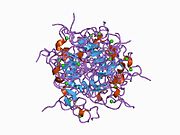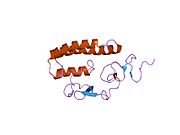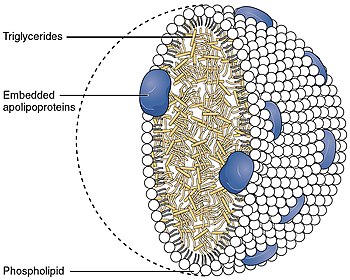LRP1
Ensembl | |||||||||
|---|---|---|---|---|---|---|---|---|---|
| UniProt | |||||||||
| RefSeq (mRNA) | |||||||||
| RefSeq (protein) | |||||||||
| Location (UCSC) | Chr 12: 57.13 – 57.21 Mb | Chr 10: 127.37 – 127.46 Mb | |||||||
| PubMed search | [3] | [4] | |||||||
| View/Edit Human | View/Edit Mouse |
Low density lipoprotein receptor-related protein 1 (LRP1), also known as alpha-2-macroglobulin receptor (A2MR), apolipoprotein E receptor (APOER) or cluster of differentiation 91 (CD91), is a
Structure
The LRP1 gene encodes a 600 kDa
Function
LRP1 is a member of the LDLR family and ubiquitously expressed in multiple
Clinical significance
Alzheimer's disease
LRP1 is also implicated in the effective clearance of Aβ from the brain to the periphery across the blood-brain barrier.[17][18] LRP1 mediates pathways that interact with astrocytes and pericytes, which are associated with the blood-brain barrier. In support of this, LRP1 expression is reduced in endothelial cells as a result of normal aging and Alzheimer's disease in humans and animal models of the disease.[19][20] This clearance mechanism is modulated by the apoE isoforms, with the presence of the apoE4 isoform resulting in reduced transcytosis of Aβ in in vitro models of the blood-brain barrier.[21] The reduced clearance appears to be, at least in part, as a result of an increase in the ectodomain shedding of LRP1 by sheddases, resulting in the formation of soluble LRP1 which is no longer able to transcytose the Aβ peptides.[22]
In addition, over-accumulation of
Cardiovascular disease
Studies have elucidated different roles for LRP1 in cellular processes relevant for cardiovascular disease.
Cancer
LRP1 is involved in tumorigenesis, and is proposed to be a tumor suppressor. Notably, LRP1 functions in clearing proteases such as
Interactions
LRP1 has been shown to
- A2-Macroglobulin,[9]
- amyloid precursor protein,[9]
- APBB1,[30]
- APOE,[9][31][32]
- Aprotinin,[9]
- CALR,[9][33]
- CD44,[8]
- Chylomicron,[9]
- Circumsporozoite protein,[9]
- Collectin,[9]
- Complement C3,[9]
- CTGF,[9]
- DLG4,[34]
- Elastase,[9]
- Factor IXa,[9]
- Factor VIIa,[9]
- Fibronectin,[9]
- Gentamicin,[9]
- GIPC1,[34]
- heparin cofactor II,[9]
- Hepatic lipase,[9]
- ITGB1BP1,[34]
- Lactoferrin,[9]
- Lipoprotein lipase,[9]
- LPL,[36][37][38]
- MAPK8IP1,[34]
- MAPK8IP2,[34]
- Midkine,[9]
- MMP2,[8]
- MMP9,[8][9]
- Neuroserpin,[9]
- Nexin-1,[9]
- NOS1AP,[34]
- PAI 2,[8]
- PDGF,[9]
- tPA,[8][9]
- uPA,[8][9]
- Polymyxin B,[9]
- Protein C inhibitor,[9]
- Pseudomonas exotoxin A,[9]
- RAP,[9]
- Ricin A,[9]
- SHC1,[39][40] and
- Sphingolipid activator protein,[9]
- SYNJ2BP.[34]
- Tat,[9]
- Thrombin,[9]
- THBS1,[9][41][42][43]
- Thrombospondin 2,[9]
- TIMP1,[8]
- TIMP2,[8]
- TIMP3,[8]
- Tissue factor pathway inhibitor,[9]
- Transforming growth factor-β,[9]
- PLAUR,[46]
- VLDL,[9]
Interactive pathway map
Click on genes, proteins and metabolites below to link to respective articles. [§ 1]
- ^ The interactive pathway map can be edited at WikiPathways: "Statin_Pathway_WP430".
See also
- Cluster of differentiation
- Low density lipoprotein receptor gene family
References
- ^ a b c GRCh38: Ensembl release 89: ENSG00000123384 – Ensembl, May 2017
- ^ a b c GRCm38: Ensembl release 89: ENSMUSG00000040249 – Ensembl, May 2017
- ^ "Human PubMed Reference:". National Center for Biotechnology Information, U.S. National Library of Medicine.
- ^ "Mouse PubMed Reference:". National Center for Biotechnology Information, U.S. National Library of Medicine.
- PMID 3266596.
- PMID 2548950.
- ^ a b "Entrez Gene: LRP1 low density lipoprotein receptor-related protein 1".
- ^ PMID 23936774.
- ^ S2CID 20991690.
- ^ PMID 26164207.
- ^ PMID 24796846.
- PMID 27503326.
- ^ PMID 21518850.
- PMID 19371428.
- PMID 18199803.
- PMID 17920016.
- PMID 19275634.
- PMID 26619118.
- PMID 11067868.
- PMID 11120756.
- S2CID 30189180.
- PMID 25015123.
- PMID 23959870.
- PMID 19667105.
- PMID 9449704.
- S2CID 2070128.
- PMID 17505534.

- PMID 21730304.
- PMID 17303763.
- PMID 9837937.
- PMID 277965.
- PMID 2762297.
- PMID 12821648.
- ^ PMID 10827173.
- PMID 11290339.
- PMID 7510694.
- PMID 7989348.
- PMID 1281473.
- PMID 12789267.
- PMID 11854294.
- S2CID 12198474.
- PMID 9045712.
- PMID 7775583.
- PMID 10632583.
- PMID 1502153.
- PMID 11359936.
Further reading
- Li Z, Dai J, Zheng H, Liu B, Caudill M (Mar 2002). "An integrated view of the roles and mechanisms of heat shock protein gp96-peptide complex in eliciting immune response". Frontiers in Bioscience. 7 (4): d731–51. PMID 11861214.
- van der Geer P (May 2002). "Phosphorylation of LRP1: regulation of transport and signal transduction". Trends in Cardiovascular Medicine. 12 (4): 160–5. PMID 12069755.
- May P, Herz J (May 2003). "LDL receptor-related proteins in neurodevelopment". Traffic. 4 (5): 291–301. S2CID 23565545.
- Llorente-Cortés V, Badimon L (Mar 2005). "LDL receptor-related protein and the vascular wall: implications for atherothrombosis". Arteriosclerosis, Thrombosis, and Vascular Biology. 25 (3): 497–504. PMID 15705932.
- Huang SS, Huang JS (Oct 2005). "TGF-beta control of cell proliferation". Journal of Cellular Biochemistry. 96 (3): 447–62. S2CID 83711249.
- Lillis AP, Mikhailenko I, Strickland DK (Aug 2005). "Beyond endocytosis: LRP function in cell migration, proliferation and vascular permeability". Journal of Thrombosis and Haemostasis. 3 (8): 1884–93. S2CID 20991690.
External links
- CD91+Antigen at the U.S. National Library of Medicine Medical Subject Headings (MeSH)







